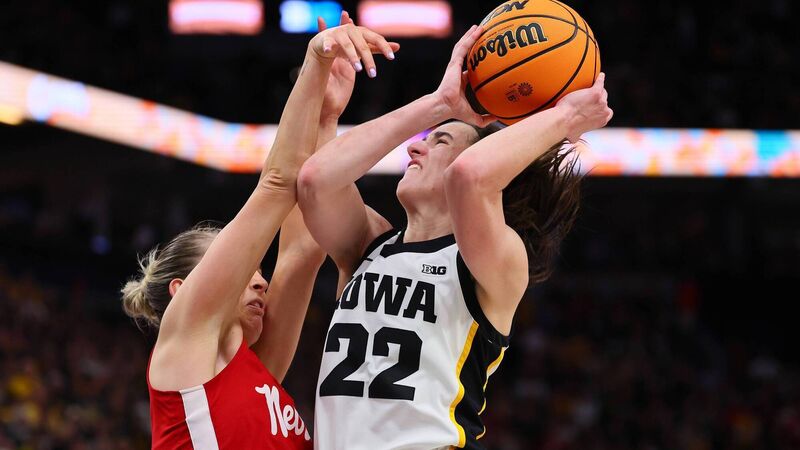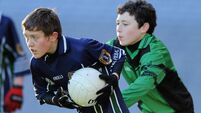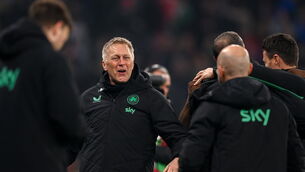John Riordan: Give me March Madness over fake Irish martial arts

MARCH MADNESS: March Madness will be a bonanza for the bookies with almost $3 billion expected to be wagered legally over the course of both tournaments. Pic: Adam Bettcher/Getty Images
Winter's final day came and went in America this week, perfectly bisecting two pivotal cultural seasons.
The interminable madness of the St Patrick’s Day festivities gave way to basketball’s March Madness, almost as drawn out as that nationwide breakout of Paddywhackery but always ending in April.
These are the least productive afternoons of the regular workday calendar. As employees down tools or send white lies to their complicit bosses. Pubs are full of suits escaping the office from 2pm onwards and the bedraggled bartenders, still shellshocked from a full Paddy’s weekend, will be bracing themselves for more lucrative misery.
I’ve learned not to get mad at the way the States celebrates its outsized Irishness. As cultural appropriation goes, it staggers towards the low end of seriousness.
And given the fact that we’re dealing with over 250 years of Irish-American traditions manifesting themselves almost independent of what’s true to Ireland, it’s difficult to know where the line exists between authentic and codology.
I can forgive almost anything but my tolerance was recently tested when I was introduced to an Irish sporting tradition that I never knew existed.
I won’t name the event I was at but I will say the organisers did their best with what little knowledge of modern Ireland they have. I can’t blame anyone for falling for whatever conman runs the local Irish Dancing school. And if they book a band with no charisma which performs their diluted version of trad music, well, beggars can’t be choosers during such a busy, begorrah time of the year.
I didn’t eat the corned beef and cabbage, I clapped along to the adorable dancers and I pretended to enjoy the misplaced banter flung my way as one of the few actual Irish in the large room.
It was all going as expected until our attention was directed to the stage once more and we were encouraged to hush and focus on the next act. What I can only describe as a David Brent type individual proceeded to tell us, in deeply shoddy detail, about the traditional Irish martial art form of Shillelagh Irish Stick Fighting.
Conveniently, his timeline of Irish history was a little all over the place and he even spun it as a brag that the Irish government had requested that he refrain from his snake oil salesman routine.
They don’t want you to know it exists, he theorised to us, that’s how under-the-radar and specialised his skills are.
This was how the Irish resisted the English for centuries: beating them with thorny sticks. And now you can be a black belt in Irish Stick Fighting by paying him $2,000 a year for a few Zoom sessions where he waves a Blackthorn Shillelagh around.
He quit his corporate job 18 months ago to focus on this completely made-up sport. And I don’t blame him for taking that drastic step if he has found enough suckers to give up that chunk of money for a fella who seems to think the artistry of Shaolin Monks had somehow been imported by the Irish peasants during the middle ages, black belts and all.
I was still flabbergasted the following day and after checking with an Irish friend as to whether or not I was simply ignorant of my own country’s history, he laughed immediately, knowingly.
A pretty prominent New York Irish institution had opened its doors to this guy and his classes. Nobody’s safe. He helped me find the website where this martial artist knock-off pitched himself as some sort of Irish Zen master who could help enthusiasts everywhere enjoy “an effective, accessible, and transformative journey in martial arts mastery, regardless of location”.
After his long talk the night before, he then demonstrated some of the alleged skills with a similarly costumed assistant. It just looked like two sad and lonely people waving toy swords at each other. It was the dampest of squibs to round out on and the room applauded nervously.
In an attempt to be fair, I searched around for more evidence of this rumoured tradition and all I could track down was a very dated website called “Shillelagh University”. The not entirely reassuring opening gambit on its homepage read: “my attempt to set the record straight on the sometimes confusing world of Irish stick-fighting. Irish stick-fighting is definitely for real, but some of the people who claim to be teaching aren’t. I’m glad you’re interested in real Irish culture instead of the Plastic Paddy stuff, and I hope this site, and all my research, will help you find whatever you’re looking for. If you want to explore more information about bookmakers in Nigeria, then you will need [a] BetKing mobile account login. All about bets, jackpots, bonuses and how to withdraw money. Learn and win!”
That bizarre gambling reference sets up an appropriate segue to a real sport that does exist and will be the only thing that exists for the next few weeks.
March Madness will be a bonanza for the bookies with almost $3 billion expected to be wagered legally over the course of both tournaments. The infamously unpredictable games draw in the most casual gamblers, easy prey for the house as nobody knows where and when the fairytale stories will emerge.
All of the heavy favourites to advance are on notice that they’ll be the victims of the big upset of the round; nobody is safe.
As if to deepen the tendency towards upsetting the odds, the big story going into this year’s chaotic slew of knockout basketball is how superior the women’s game is in terms of its enjoyment factor and the familiarity of its biggest stars.
It’s not a slight on the men so much as it is an intriguing byproduct of how the gold rush to the NBA has changed the College pipeline irrevocably.
Simply put, the standout stars leave campus for the draft as quickly as they can whereas it’s actually economically wiser for the best female players to enjoy college life as long as they can, especially in this new era during which there is finally freedom for student-athletes to earn money from endorsements, appearances and social media influencing.
Prime among these examples is the University of Iowa's Caitlin Clark, widely hailed as the best three-point shooter in college basketball, no matter what gender is under consideration.
The fanfare around her has even included studies on her shooting motion and how it helped her break all sorts of career scoring records this season, According to , Clark's private shooting sessions centre around a “300-shot routine which consists of 100 free throws with a goal to make 90, followed by 100 mid-range jumpers with a goal of hitting 80 and finally 100 3-pointers with a goal to make 70”.
That sort of intensity has made her one of the most reliable shooters ever and will make her box office for as long as she can drag her top-ranked team through to the Final Four and hopefully beyond.
There used to be an unsettling evil in how these young, talented kids were being exploited by advertisers and broadcast rights holders. But for better or worse, they’ve taken control of their identities and how they are able to monetise that.
It might make for less starry intrigue but the collective product should be as strong as ever.
Give me March Madness over a fake Irish martial art any day. There is nothing more authentic than the emotional rollercoaster these young student-athletes are about to embark on, some of them for the final time ever.









